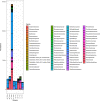Nasopulmonary mites (Acari: Halarachnidae) as potential vectors of bacterial pathogens, including Streptococcus phocae, in marine mammals
- PMID: 35709209
- PMCID: PMC9202935
- DOI: 10.1371/journal.pone.0270009
Nasopulmonary mites (Acari: Halarachnidae) as potential vectors of bacterial pathogens, including Streptococcus phocae, in marine mammals
Abstract
Nasopulmonary mites (NPMs) of the family Halarachnidae are obligate endoparasites that colonize the respiratory tracts of mammals. NPMs damage surface epithelium resulting in mucosal irritation, respiratory illness, and secondary infection, yet the role of NPMs in facilitating pathogen invasion or dissemination between hosts remains unclear. Using 16S rRNA massively parallel amplicon sequencing of six hypervariable regions (or "16S profiling"), we characterized the bacterial community of NPMs from 4 southern sea otters (Enhydra lutris nereis). This data was paired with detection of a priority pathogen, Streptococcus phocae, from NPMs infesting 16 southern sea otters and 9 California sea lions (Zalophus californianus) using nested conventional polymerase chain reaction (nPCR). The bacteriome of assessed NPMs was dominated by Mycoplasmataceae and Vibrionaceae, but at least 16 organisms with pathogenic potential were detected as well. Importantly, S. phocae was detected in 37% of NPM by nPCR and was also detected by 16S profiling. Detection of multiple organisms with pathogenic potential in or on NPMs suggests they may act as mechanical vectors of bacterial infection for marine mammals.
Conflict of interest statement
The authors have declared that no competing interests exist.
Figures



Similar articles
-
Nasopulmonary mites (Halarachnidae) of coastal Californian pinnipeds: Identity, prevalence, and molecular characterization.Int J Parasitol Parasites Wildl. 2021 Aug 14;16:113-119. doi: 10.1016/j.ijppaw.2021.08.005. eCollection 2021 Dec. Int J Parasitol Parasites Wildl. 2021. PMID: 34485053 Free PMC article.
-
PREVALENCE, PATHOLOGY, AND RISK FACTORS ASSOCIATED WITH STREPTOCOCCUS PHOCAE INFECTION IN SOUTHERN SEA OTTERS (ENHYDRA LUTRIS NEREIS), 2004-10.J Wildl Dis. 2016 Jan;52(1):1-9. doi: 10.7589/2015-02-048. Epub 2015 Nov 10. J Wildl Dis. 2016. PMID: 26555115
-
Molecular characterization and prevalence of Halarachne halichoeri in threatened southern sea otters (Enhydra lutris nereis).Int J Parasitol Parasites Wildl. 2018 Sep 29;7(3):386-390. doi: 10.1016/j.ijppaw.2018.09.009. eCollection 2018 Dec. Int J Parasitol Parasites Wildl. 2018. PMID: 30370218 Free PMC article.
-
Transmission of Toxoplasma: clues from the study of sea otters as sentinels of Toxoplasma gondii flow into the marine environment.Int J Parasitol. 2005 Oct;35(11-12):1155-68. doi: 10.1016/j.ijpara.2005.07.002. Int J Parasitol. 2005. PMID: 16157341 Review.
-
Recent epidemiologic and clinical importance of Toxoplasma gondii infections in marine mammals: 2009-2020.Vet Parasitol. 2020 Dec;288:109296. doi: 10.1016/j.vetpar.2020.109296. Epub 2020 Oct 26. Vet Parasitol. 2020. PMID: 33271425 Review.
Cited by
-
First record of Orthohalarachneattenuata in Arctocephalusaustralis in mainland Argentina (Parasitiformes, Mesostigmata, Dermanyssoidea, Halarachnidae) with observations on its ambulacral morphology.Zookeys. 2024 Jul 24;1207:355-368. doi: 10.3897/zookeys.1207.127297. eCollection 2024. Zookeys. 2024. PMID: 39091451 Free PMC article.
-
Survival and adaptation of Streptococcus phocae in host environments.PLoS One. 2024 Jan 30;19(1):e0296368. doi: 10.1371/journal.pone.0296368. eCollection 2024. PLoS One. 2024. PMID: 38289941 Free PMC article.
-
First report of a severe nasopulmonary acariasis caused by Orthohalarachne diminuata Doetschman, 1944 (Acari: Halarachnidae) in a captive South American sea lion (Otaria flavescens Shaw, 1800).Int J Parasitol Parasites Wildl. 2022 Nov 2;19:248-256. doi: 10.1016/j.ijppaw.2022.10.005. eCollection 2022 Dec. Int J Parasitol Parasites Wildl. 2022. PMID: 36388725 Free PMC article.
-
Non-invasive detection of Orthohalarachne attenuata (Banks, 1910) and Orthohalarachne diminuata (Doetschman, 1944) (Acari: Halarachnidae) in free-ranging synanthropic South American sea lions Otaria flavescens (Shaw, 1800).Int J Parasitol Parasites Wildl. 2023 Jun 3;21:192-200. doi: 10.1016/j.ijppaw.2023.06.001. eCollection 2023 Aug. Int J Parasitol Parasites Wildl. 2023. PMID: 37575668 Free PMC article.
References
-
- Kenyon K, Yunker C, Newell I. Nasal mites (Halarachnidae) in the sea otter. The Journal of Parasitology. 1965;51: 960. - PubMed
-
- Pesapane R, Dodd E, Javeed N, Miller M, Foley J. Molecular characterization and prevalence of Halarachne halichoeri in threatened southern sea otters (Enhydra lutris nereis). International Journal for Parasitology: Parasites and Wildlife. 2018;7: 386–390. doi: 10.1016/j.ijppaw.2018.09.009 - DOI - PMC - PubMed
-
- Furman D, Dailey M. The genus Halarachne (Acari: Halarachnidae), with the description of a new species from the Hawaiian Monk Seal. Journal of Medical Entomology. 1980;17: 352–359.
-
- Fravel V, Procter D. Successful diagnosis and treatment of Orthohalarachne attenuata nasal mites utilising voluntary rhinoscopy in three Pacific walrus (Odobenus rosmarus divergens). Veterinary Record Case Reports. 2016;4: e000258.
-
- Domrow R. Halarachne miroungae Ferris redescribed (Acarina: Laelaptidae). Pacific Insects. 1962;4: 859–863.

